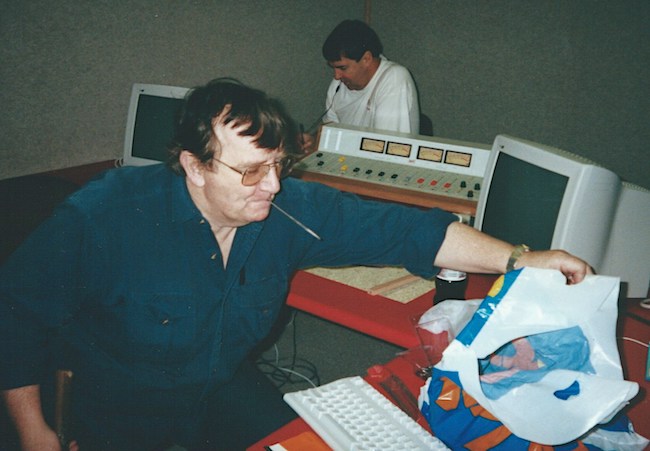Today, the Hot Country Network turns 20.
If you don’t live out west of the Great Dividing Range in Queensland, you may never have heard of this network, but it’s been part of the daily lives of many rural people for two decades.
“It was started out of necessity,” says Brad Smart, who founded the network when he owned his Smart Radio group of stations. It was a “helluva ride,” according to Brad, who tells the story of the network for radioinfo.
In 1998, Smart Radio bought 4VL in Charleville, and my wife, Judy, and I quickly realised two things.
Radio stations are a black hole when it comes to money, and you can’t make a good living out of just one small station.
As new kids on the block, we tried to buy other stations, like 4ZR in Roma and 4SB Kingaroy, but the big boys already had the market cornered, so they weren’t available.
The one thing we knew was that almost every regional AM station at the time was programmed with a Gold format. Their companion FM stations usually carried some form of CHR music.
Yet, we found that many people we met in the towns, as we travelled around southern inland Queensland, were playing Country Music in their cars, offices, trucks and tractors. If not, they were watching their favorite country music videos on CMT through Foxtel, or Austar as it was in the bush at that time.
It became apparent that what these people wanted to listen to most was modern country rock; a format, that had become hugely popular during the nineties with the emergence of Garth Brooks and Shania Twain. They weren’t hanging out for classic or yokel country, played on washboards – that time had passed.
Around October 1999, we heard about licences being available on frequencies between 1611Khz and 1710Khz in the expanded AM band, that was starting to be used in the U.S.
All we knew of these licences at that time was they were narrowcast, which really didn’t interest us.
We then discovered that they could be converted for commercial operation under Section 40 of the Broadcast Act.
Now, we thought, this was definitely worth a punt.
Applications were made and licences granted for St George, Roma, Goondiwindi and Dalby.
We would also later get an Emerald licence and a separate Section 40 commercial licence to go with it.
Checking out the various towns that we had licences for in early 2000, we thought the site with the greatest potential was Dalby.
A 30-year lease was signed with a property owner outside of town and Austower erected a 50-metre lattice tower for us with a full copper earth-mat for just $25,000, a remarkably cheap price, even at the time.
A shipping container was bought from a local trucking yard, power was connected, and Sydney broadcast engineer, John Aitken, supplied a 1Kw AM Pulse transmitter, which he matched to the antenna.
We were almost ready to go, except, we needed studios.
Working 18 hours a day, it took two weeks for four of us to fit out two studios and a news booth in the Ergon Energy building in Dalby.

Although we’d been running on-air tests off and on for several days, Radio 4DB, known on air as Hot Country, finally went to air at 5am on the morning of 14th August 2000.
Russ McEwan, who now runs Australia’s Voiceover House, became ‘Big Russ’, our first breakfast announcer, and Dave Nugent, who’d worked with us at Charleville and wanted to get back closer to his home base in Kingaroy, also came along for the ride. There were eight staff in all at Dalby when we started, covering sales, on-air, programming and news.
I’d love to be able to tell you it was an instant smash hit, but like most new businesses, that wasn’t the case.
Business people in the town weren’t used to buying local radio, and for the sales team, it was a bit like getting blood out of a stone.
To give you an idea of this town’s group mindset, the owner of a large hardware store in Dalby had allegedly led the campaign 20 years before against the Warrego Highway being bitumenised because ‘my customers will all drive into Toowoomba to get better deals.’
In reality, the going was pretty tough and we lost a lot of money in those early months.
About a year later, we shut the Dalby studios and ran the station from a second studio in Charleville, linking directly to the Dalby transmitter with an ISDN line, and using the 4VL announcers.
But, things were changing in the world of S40 licences in 2002.
Only 16 Section 40 licenses were ever issued, but they upset some sections of commercial radio.
On 6th November 2002, the Communications Minister Richard Alston, finally stopped narrowcast licences becoming commercial.
For us, that could have been the end of the saga, but luckily, Minister Alston grandfathered S40 licenses that were issued before that cut-off date, providing they were on-air by the end of August 2004.
The remaining four sites, Goondiwindi, St George, Roma and Emerald were constructed and commissioned, complete with ploughed-in 100m-long earthmats in just 10 days. The last site, Emerald, going to air at 6pm on 31 August 2004. Just made it!
The reason we had delayed bringing the additional sites on-line was communications. Faced with the tyranny of distance in outback Queensland, we couldn’t get our program to the transmitters at a reasonable cost.
It wasn’t until August 2004 that we completed the installation of our satellite network, from which the various stations downlinked the Hot Country program. The uplink was sited in Charleville.
In 2005, after driving every month from Melbourne to Charleville and back since 1998, we decided to relocate ourselves to the Sunshine Coast.
That’s when we got serious about the Hot Country stations.
At the last four sites, we had only used 50 watt transmitters when we put them on air.
We replaced those ‘pee-whistles’ with Blyth 1KW transmitters, which we ran at our maximum power of 400 watts. They’re still in service today.
On the programming side, we re-structured the format and tightly imaged the station with sweepers voiced by the legendry Jim Pilgrim.
As soon as we went to air on full power, people started to hear about this new station playing country rock.
Obviously, at 1611 & 1629, advertisers always tried to make frequency an issue, but people found ways to listen to us.
All bedside radios could get the signal without much problem and a number of manufacturers, including Sanyo and Panasonic, had digital boomboxes that went up to 1629.
About 80% of car radios in the day also covered the expanded band.
There was a buzz about this new station and people were listening.
We relocated the studios to Noosa in 2006 and employed two announcers – Trish Espin and Ron Boileau, who stayed with the network until after Macquarie bought it.
Des Deighton, who is now with Sunshine FM, became our regular Saturday morning guy, fielding Sell, Swap & Buy calls from all over western Queensland.
How this off-band network became a commercial success was thanks to the marketing genius of former ACE Radio executive, Bob Harding.
Bob developed and co-ordinated a grass-roots direct sales operation in every market, with reps who really knew their clients.
He kept them fed with props that were often based on the many listen-to-win competitions we ran continuously.
Within months, the revenue started to climb.
By 2007, Hot Country was grossing $830k a year, about the same as 4HI and 4LM at the time. After seven years, on paper, it was in the black.
Hot Country remained very popular and a good revenue generator over the next five years.
Almost through osmosis, the network also became an important part of the country music scene.
Our Hot Country Top 50 chart, which we started in 2004 to help us with our music programming, was eventually relied on as an industry reference.
The network was named the 2012 Country Music Station of the Year at the Tamworth Country Music Awards.
In 2008, Judy and I bought 4HI Emerald and 4ZR Roma, where we also had Hot Country outlets.
We kept Hot Country all music on weekends as a refuge for people who didn’t want to listen to sport on the heritage AM stations, or tune to what inlanders called the ‘head-banging’ stuff on SCA’s local FM station.
But like all good things, it seems, other people always know how they can do it better than you.
Shortly after Macquarie Radio bought all our stations, Ray Hadley allegedly went to a football match at Tara on the Darling Downs and heard that Hot Country wasn’t playing the Continuous Call Team.
Word got back that he wasn’t happy.
The next week, Country was gone on Saturday and Sunday afternoons, and the same footy talk show was on both of the Macquarie-owned stations in each of the markets.
In search of music, many locals decided to sample the FM competitors, and as recent ratings show, a lot of them stayed.
Now, Resonate owns the Hot Country Network.
I like that!
They’re an independent operation and I certainly hope they’ll continue giving the people of inland Queensland the country music that many of them love so much.
With 20-years behind it, the Hot Country Network has grown up and can claim a history that’s made a worthwhile contribution to Australian Radio.
To me, it’s a sign that what you dream can become a reality.
About the Author
 Brad Smart previously owned and operated the Smart Radio Network through regional Queensland.
Brad Smart previously owned and operated the Smart Radio Network through regional Queensland.
He sold his stations to the then Macquarie Radio Network.
He has been a journalist, broadcaster and film producer for over 30 years.
Brad’s articles and podcasts are also available through his website www.bradsmart.com.au
Subscribe to the radioinfo daily flash briefing podcast on these platforms: Acast, Apple iTunes Podcasts, Podtail, Spotify, Google Podcasts, TuneIn, or wherever you get your podcasts.


